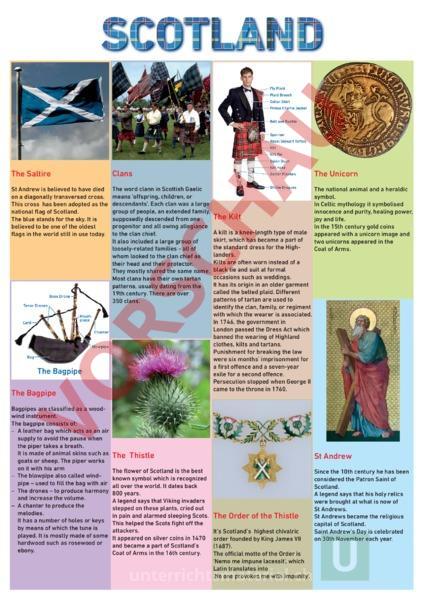Arbeitsblatt: NW3 U1 Scotland Poster
Material-Details
Poster im A1-Format zu Schottland.
Englisch
Lehrmittel
7. Schuljahr
1 Seiten
Statistik
181980
689
11
24.06.2018
Autor/in
Thomas Hostettler
Land: Schweiz
Registriert vor 2006
Textauszüge aus dem Inhalt:
The Saltire Clans The Unicorn St Andrew is believed to have died on diagonally transversed cross. This cross has been adopted as the national flag of Scotland. The blue stands for the sky. It is believed to be one of the oldest flags in the world still in use today. The word clann in Scottish Gaelic means offspring, children, or descendants. Each clan was large group of people, an extended family, supposedly descended from one progenitor and all owing allegiance to the clan chief. It also included large group of loosely-related families all of whom looked to the clan chief as their head and their protector. They mostly shared the same name. Most clans have their own tartan patterns, usually dating from the 19th century. There are over 350 clans. The national animal and heraldic symbol. In Celtic mythology it symbolised innocence and purity, healing power, joy and life. In the 15th century gold coins appeared with unicorn image and two unicorns appeared in the Coat of Arms. The Bagpipe Bagpipes are classified as woodwind instrument. The bagpipe consists of: – leather bag which acts as an air supply to avoid the pause when the piper takes breath. It is made of animal skins such as goats or sheep. The piper works on it with his arm – The blowpipe also called windpipe – used to fill the bag with air – The drones – to produce harmony and increase the volume. – chanter to produce the melodies. It has number of holes or keys by means of which the tune is played. It is mostly made of some hardwood such as rosewood or ebony. The Kilt kilt is knee-length type of male skirt, which has became part of the standard dress for the Highlanders. Kilts are often worn instead of black tie and suit at formal occasions such as weddings. It has its origin in an older garment called the belted plaid. Different patterns of tartan are used to identify the clan, family, or regiment with which the wearer is associated. In 1746, the government in London passed the Dress Act which banned the wearing of Highland clothes, kilts and tartans. Punishment for breaking the law were six months imprisonment for first offence and seven-year exile for second offence. Persecution stopped when George II came to the throne in 1760. The Thistle St Andrew The flower of Scotland is the best known symbol which is recognized all over the world. It dates back 800 years. legend says that Viking invaders stepped on these plants, cried out in pain and alarmed sleeping Scots. This helped the Scots fight off the attackers. It appeared on silver coins in 1470 and became part of Scotlands Coat of Arms in the 16th century. Since the 10th century he has been considered the Patron Saint of Scotland. legend says that his holy relics were brought at what is now of St Andrews. St Andrews became the religious capital of Scotland. Saint Andrew Day is celebrated on 30th November each year. The Order of the Thistle Its Scotlands highest chivalric order founded by King James VII (1687). The official motto of the Order is Nemo me impune lacessit, which Latin translates into No one provokes me with impunity.
